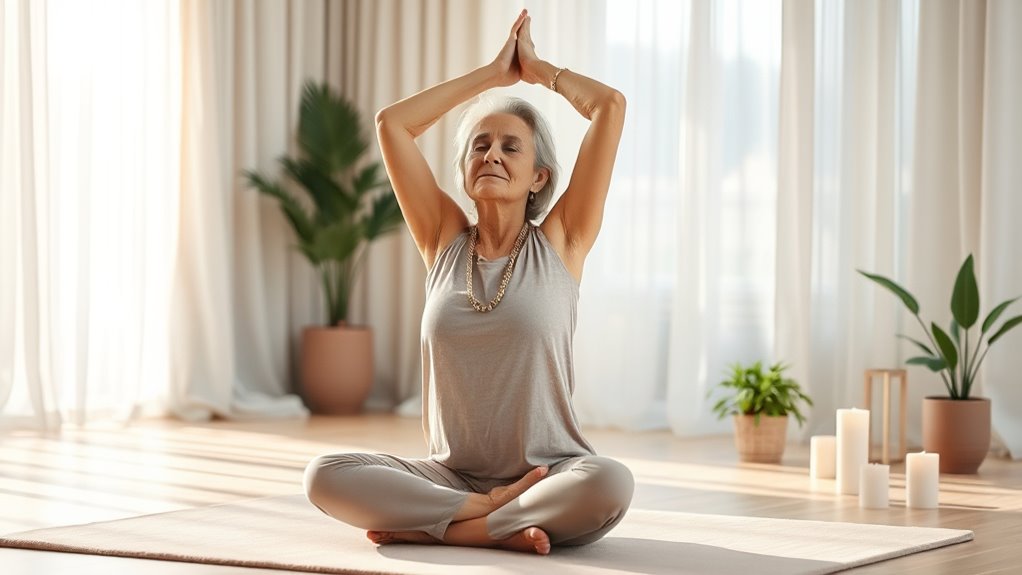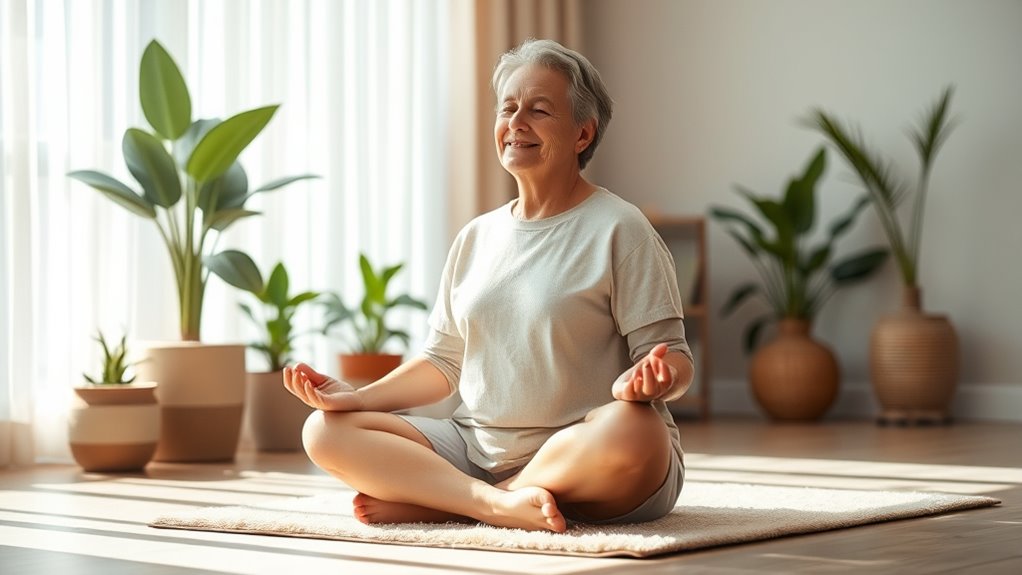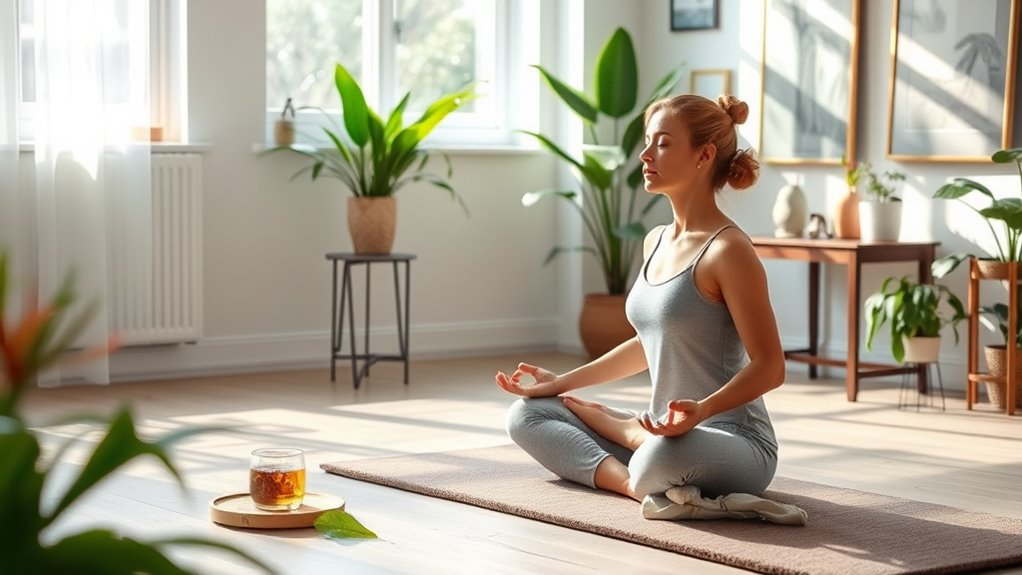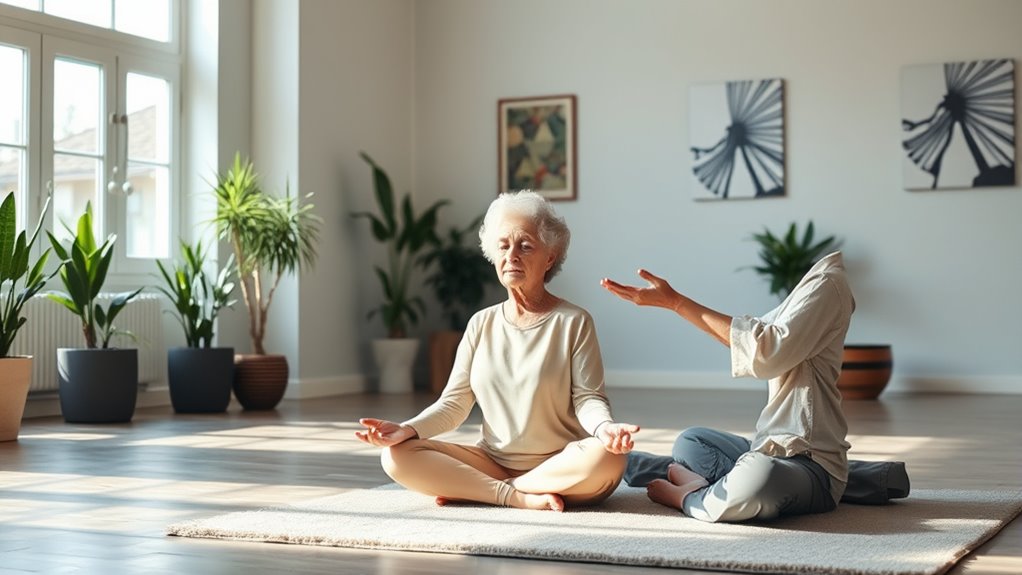To reduce arthritis flare-ups, incorporate mind-body strategies like stress management, mindfulness, yoga, and visualization into your routine. These techniques help lower inflammation, relax muscles, and improve emotional well-being, which can lessen the frequency and severity of flares. Establishing consistent practices and combining them with healthy lifestyle choices amplifies their benefits. Keep exploring ways to integrate these approaches, and you’ll discover effective methods to manage symptoms and enhance your quality of life.
Key Takeaways
- Regular relaxation techniques like deep breathing, meditation, and progressive muscle relaxation help activate the body’s relaxation response, reducing stress-induced flare-ups.
- Mindfulness practices and guided imagery promote mental calmness, lower inflammation, and decrease the severity and frequency of arthritis episodes.
- Gentle yoga and diaphragmatic breathing improve joint flexibility, circulation, and muscle tension, aiding in inflammation reduction and pain management.
- Establishing consistent daily routines for mind-body exercises enhances resilience to stress and supports long-term symptom control.
- Combining lifestyle changes such as anti-inflammatory diet, adequate sleep, and stress reduction amplifies the benefits of mind-body approaches in decreasing flare frequency.
Understanding the Connection Between Stress and Arthritis Flare-Ups

Stress can profoundly impact your arthritis symptoms, often triggering flare-ups or making existing pain worse. When you’re stressed, your body releases hormones like cortisol and adrenaline, which can increase inflammation in your joints. This heightened inflammation intensifies pain, swelling, and stiffness, leading to more frequent or severe flare-ups. Additionally, stress can cause muscle tension, reducing joint mobility and making movement uncomfortable. You might also notice that during stressful periods, you’re less likely to follow your usual self-care routines, which can worsen symptoms. Recognizing this connection helps you understand why managing stress is vital for controlling arthritis. By reducing stress, you can lower inflammation levels, ease joint pain, and improve your overall quality of life.
The Role of Mindfulness Meditation in Managing Arthritis Symptoms

Practicing mindfulness meditation offers a powerful way to manage arthritis symptoms by helping you stay present and reduce emotional responses that can exacerbate pain. When you focus on your breath and observe your thoughts without judgment, you create a sense of calm that can lessen muscle tension and inflammation. Regular mindfulness practice can help break the cycle of stress and pain, making flare-ups less intense and more manageable. It also enhances your awareness of pain signals, enabling you to respond more calmly rather than react negatively. Incorporating relaxation techniques like deep breathing exercises can further enhance the benefits of mindfulness. Additionally, understanding the importance of mind-body connection can motivate consistent practice. Developing a positive mindset through mindfulness may also contribute to better pain management and emotional resilience. Recognizing the influence of contrast ratio on visual clarity underscores the importance of maintaining mental clarity and focus during meditation. Over time, mindfulness can improve your overall well-being, reduce anxiety, and promote better sleep—all of which support arthritis management. Incorporating just a few minutes of meditation daily can make a noticeable difference in your symptom control.
Yoga Practices That Help Reduce Inflammation and Pain

Did you know that certain yoga practices can help reduce inflammation and alleviate pain associated with arthritis? Gentle yoga poses focus on stretching and strengthening muscles, which can improve joint flexibility and reduce stiffness. Specific postures, like cat-cow, downward dog, and seated twists, promote better circulation and stimulate lymphatic flow, helping to decrease inflammation. Regular practice can also release endorphins, natural painkillers that boost your mood and lower discomfort. Brewing techniques can also be adapted to support your practice by ensuring you stay well-hydrated and energized during your routine. Proper plant care, such as using suitable watering pots and planters, can further enhance your overall well-being by creating a calming environment that encourages relaxation. Additionally, incorporating appropriate exercise routines can help strengthen muscles around affected joints, providing better support and reducing pain. Maintaining a consistent yoga routine can also promote proper joint alignment, which is crucial for minimizing strain and preventing further discomfort. By maintaining a consistent yoga routine, you can enhance your body’s ability to manage arthritis symptoms more effectively. Remember to listen to your body and modify poses as needed to avoid overstressing your joints. Incorporating these mindful movements into your daily routine can support pain relief and improve overall joint health. Heartfelt encouragement can motivate you to stay consistent and patient with your practice.
Deep Breathing Techniques for Calmness and Symptom Relief

Deep breathing techniques can activate your relaxation response, helping your body calm down. By practicing these methods regularly, you can better manage stress levels that may worsen arthritis symptoms. Incorporating deep breaths into your routine offers a simple way to find relief and promote overall calmness. Research supports that stress management techniques can significantly reduce flare frequency and improve quality of life. Engaging in these practices can also positively influence mind-body approaches, further supporting your health. Additionally, integrating glycolic acid treatments, which promote skin renewal and reduce inflammation, can enhance overall well-being and reduce stress.
Enhances Relaxation Response
By engaging in slow, intentional breathing, you can activate your body’s relaxation response, helping to reduce stress and ease arthritis symptoms. This response lowers heart rate, blood pressure, and muscle tension, creating a calming effect. Regular practice strengthens your ability to enter a relaxed state quickly, making it easier to manage flare-ups. To enhance this response, consider:
- Focusing on deep, diaphragmatic breaths
- Counting each inhale and exhale to maintain rhythm
- Breathing through your nose for better oxygen exchange
- Pausing briefly between breaths to deepen relaxation
- Combining breathing with gentle visualization techniques
These simple steps reinforce your body’s natural relaxation mechanism, promoting long-term relief and resilience against stressors that trigger arthritis symptoms.
Manages Stress Levels
Building on your ability to activate the relaxation response, deep breathing techniques are powerful tools for managing stress levels and promoting calmness. When you focus on slow, deep breaths, you signal your nervous system to relax, reducing the physical effects of stress. Practice inhaling through your nose for four seconds, holding your breath for a count of four, then exhaling slowly through your mouth for six seconds. Repeat this cycle several times, paying attention to the sensation of breath and letting go of tension. Regular practice helps you develop greater control over your stress response, which can lessen arthritis flare-ups. Over time, deep breathing becomes a quick, effective way to calm your mind and body, especially during stressful moments that might trigger symptoms.
Incorporating Guided Imagery and Visualization for Pain Management

Guided imagery and visualization can activate your relaxation response, helping to reduce pain and stress. By mentally rehearsing calming scenes or positive outcomes, you strengthen your mind-body connection. This practice can make managing arthritis symptoms more effective and empowering. Additionally, incorporating mindfulness techniques can further enhance this benefit by promoting present-moment awareness. Utilizing sound design elements such as calming sounds or ambient music during visualization sessions can deepen relaxation and improve overall effectiveness.
Relaxation Response Activation
Activating the relaxation response can be a powerful tool for managing arthritis pain, especially when you use guided imagery and visualization techniques. These methods help calm your nervous system, reducing muscle tension and lowering stress hormones that can worsen pain. To activate this response, find a quiet space, breathe deeply, and imagine peaceful scenes or healing visuals. Incorporate these strategies to deepen your relaxation:
- Focus on a calming mental image
- Use detailed sensory descriptions
- Practice slow, deep breathing
- Repeat positive affirmations
- Engage your senses to enhance imagery
Consistently practicing these techniques trains your body to respond with relaxation, helping you better manage flare-ups and improve overall well-being. Over time, this approach can markedly reduce the frequency and intensity of arthritis pain episodes.
Mental Rehearsal Benefits
Practicing relaxation techniques like visualization not only calms your nervous system but also enhances your ability to manage arthritis pain through mental rehearsal. When you vividly imagine yourself in a peaceful setting or performing pain-free activities, your brain creates new neural pathways that reinforce positive sensations. This mental practice can reduce the intensity and frequency of flare-ups over time. Guided imagery helps shift your focus away from pain, promoting relaxation and emotional resilience. Regular visualization sessions strengthen your mind-body connection, making it easier to access calmness during flare-ups. By consistently engaging in these techniques, you train your mind to respond more effectively to discomfort, empowering you to take control of your pain management and improve your overall well-being.
The Benefits of Progressive Muscle Relaxation in Arthritis Care

Progressive muscle relaxation (PMR) offers a practical way to manage arthritis symptoms by reducing stress and easing muscle tension. When you practice PMR, you systematically tense and relax muscle groups, which helps decrease overall pain and stiffness. This technique enhances body awareness and encourages relaxation, making flare-ups less intense. Regular practice can improve sleep quality, reduce anxiety, and promote a sense of control over symptoms.
Some benefits include:
- Lowering stress levels that trigger flare-ups
- Improving joint flexibility and movement
- Reducing muscle stiffness and soreness
- Enhancing overall relaxation and calmness
- Supporting better sleep and mood
Creating a Consistent Routine of Mind-Body Exercises for Long-Term Benefits

Establishing a consistent routine of mind-body exercises is key to maintaining the long-term benefits you’ve experienced, such as reduced stress and improved muscle relaxation. To do this, set aside a specific time each day, making it a non-negotiable part of your schedule. Start with manageable sessions, gradually increasing duration or frequency as you feel comfortable. Focus on techniques like meditation, deep breathing, or gentle yoga, and practice them regularly to reinforce their effects. Keep track of your progress, and be patient—consistency is more important than intensity. Over time, these exercises will become a natural part of your daily life, helping you better manage arthritis symptoms and reduce flare-ups. Remember, persistence is essential for lasting benefits.
Combining Lifestyle Changes With Mind-Body Strategies for Better Outcomes

To achieve the best results in managing arthritis, it’s essential to combine lifestyle changes with your mind-body strategies. These adjustments can enhance your overall well-being and reduce flare-ups. Focus on nourishing your body with anti-inflammatory foods like fruits, vegetables, and omega-3-rich fish. Incorporate regular, gentle exercise to improve joint flexibility and strength. Prioritize quality sleep to support healing and energy levels. Manage stress through mindfulness or meditation to lower inflammation. Finally, avoid smoking and limit alcohol intake, which can worsen symptoms.
Combining lifestyle changes with mind-body strategies reduces arthritis flare-ups and boosts overall well-being.
Consider these lifestyle strategies:
- Adopting an anti-inflammatory diet
- Incorporating low-impact exercise routines
- Ensuring sufficient, restful sleep
- Practicing stress reduction techniques
- Avoiding tobacco and limiting alcohol
Frequently Asked Questions
Can Mind-Body Techniques Replace Medication for Arthritis Management?
You might wonder if mind-body techniques can substitute medication for arthritis management. While these methods, like meditation and relaxation, can reduce stress and improve your well-being, they shouldn’t replace prescribed medications. Instead, they serve as complementary tools to help manage symptoms and reduce flare-ups. Always consult your healthcare provider before making any changes to your treatment plan to ensure safety and effectiveness.
How Quickly Can I Expect to See Improvements Using These Approaches?
You might wonder how fast you’ll notice benefits from these approaches. Generally, some people see improvements within a few weeks, especially with consistent practice. Others may take longer, around a few months, to experience significant changes. Keep in mind, individual results vary based on dedication and the severity of your arthritis. Staying committed and patient increases your chances of experiencing meaningful relief through these techniques.
Are There Any Risks or Contraindications for Practicing Yoga or Meditation?
Think of yoga and meditation as gentle companions on your health journey. While generally safe, you should be cautious if you have severe joint damage or specific health conditions. Avoid poses that cause pain, and always listen to your body. Consult your doctor before starting, especially if you have underlying health issues. With mindful practice, these approaches can be safe and beneficial, helping soothe your arthritis symptoms.
How Do These Methods Affect Different Types of Arthritis?
You wonder how these methods impact different arthritis types. Yoga and meditation can help reduce pain and improve flexibility for conditions like rheumatoid arthritis and osteoarthritis. They promote relaxation, decrease stress, and may lessen flare-ups. However, you should tailor practices to your specific condition, avoiding overstretching or high-impact moves. Always consult your healthcare provider before starting new routines to guarantee they’re safe and effective for your arthritis type.
Can Children or Older Adults Safely Use These Mind-Body Strategies?
You might wonder if children or older adults can safely utilize these mind-body strategies. Generally, yes, but you should always consult healthcare providers first. Children benefit from gentle techniques like breathing exercises and guided imagery, while older adults should adapt practices to their physical abilities. These approaches are non-invasive and low-risk, making them suitable for many, but personalized guidance ensures safety and effectiveness.
Conclusion
Incorporating mind-body approaches can markedly reduce arthritis flare-ups, helping you regain control and improve your quality of life. Did you know that studies show mindfulness and relaxation techniques can decrease inflammation and pain by up to 30%? By consistently practicing these strategies alongside lifestyle changes, you’re empowering yourself to manage symptoms more effectively. Start small, stay committed, and watch how these simple practices transform your arthritis journey for the better.









